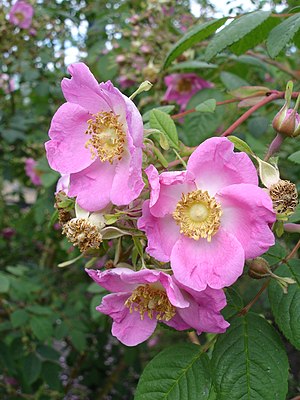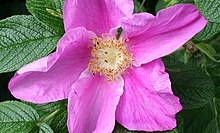Rosa caudata
| Rosa caudata | ||||||||||||
|---|---|---|---|---|---|---|---|---|---|---|---|---|

Rosa caudata |
||||||||||||
| Systematics | ||||||||||||
|
||||||||||||
| Scientific name | ||||||||||||
| Rosa caudata | ||||||||||||
| Baker |
Rosa caudata is a species of the genus roses ( Rosa ) within the family of the rose family (Rosaceae).
description
Appearance and leaf
Rosa caudata grows as a shrub and reaches heights of up to 4 meters. The stem-round branches are spread out and their bark is bare. The branches are occasionally reinforced with straight, squat, triangular spines .
The alternate leaves arranged on the branches are 10 to 20 centimeters long including the petioles. The petiole and the rhachis leaf are glandular, downy, hairy and briefly prickly. The imparipinnate leaf blade consists of seven to nine leaflets . With a length of 3 to 10 centimeters and a width of 1 to 6 centimeters, the leaflets are egg-shaped, oblong-egg-shaped or elliptical-egg-shaped with a rounded or broad-wedge-shaped base, a pointed or pointed upper end and a simply sawn edge. The broad stipules are fused with the petiole for most of their length. The leaflets are glabrous or sparsely hairy on the underside along the leaf veins . The main and side veins are raised. The free area of the stipules is ovate with a pointed upper end and a smooth edge; it can be hairy glandular and downy.
Inflorescence, flower and fruit
Rosa caudata var. Maxima are eight to ten and Rosa caudata var. Caudata has many flowers in an umbrella-shaped inflorescence with a diameter of 3.5 to 6 centimeters. The 1.5 to 4 centimeter long peduncle can be hairy with dense glandular and downy hair. There are some egg-shaped bracts present, the upper end of which is tailed and their edge can be hairy glandular.
The flowering period in China extends from June to July. The hermaphroditic, non-scented flowers are radial symmetry and five-fold with a double flower envelope . The flower cup (hypanthium) is elongated, dense glandular-downy hairy or glabrous. The five leaf-like, full-margined sepals are triangular-egg-shaped with a length of about 3 centimeters, glabrous on the underside and dense, finely hairy and clearly tailed on the upper side (hence the specific epithet caudata ). The corollas of Rosa caudata var. Maxima have a diameter of 4 to 6 centimeters and of Rosa caudata var. Caudata of 3.5 to 5 centimeters. The five pink, free petals are silky-haired or bald on the outside, depending on the variety. The petals are broadly obovate with a broad, wedge-shaped base and an edged upper end. There are many stamens present. The free styles are much shorter than the stamens and hairy downy.
In China, the rose hips ripen between July and November. When ripe, the orange-red, bristly rose hips are elongated or jug-shaped with a diameter of 2 to 2.5 centimeters. The rose hips are crowned by the durable, often upright sepals.
Systematics and occurrence
This species was found in September 1907 by Ernest Wilson in Fang Xian in the Chinese province of Hubei in the thicket at an altitude of 1,800 meters and deposited with the collection number EH Wilson 306 in the herbarium of the Arnold Arboretum . The first description of Rosa caudata was in 1914 by John Gilbert Baker in Ellen Ann Willmott : The Genus Rosa , Volume 2, p. 495. The specific epithet caudata is derived from the Latin word caudatus for tailed.
Rosa caudata belongs to the section Cinnamomae from the subgenus Rosa in the genus Rosa .
Rosa caudata thrives in forests and bushes in valleys and on slopes at altitudes of 1200 to 2500 meters in the Chinese provinces of Hubei , Shaanxi and Sichuan .
There are two varieties of Rosa caudata :
- Rosa caudata Baker var. Caudata : The petals are bare on the outside. It thrives at altitudes of 1600 to 2000 meters in Hubei, Shaanxi and Sichuan.
- Rosa caudata var. Maxima TTYu & TCKu: It was first described in 1981 and has slightly larger flowers and leaflets than the nominate form. The petals are silky hairy on the outside. It thrives in forests and on open slopes at altitudes of 1200 to 2500 meters only in Gouchang Xian in Shaanxi and Tianquan Xian in central Sichuan.
use
The single-flowering wild rose Rosa caudata is hardy to −23 ° C ( USDA zone 6 ).
swell
- Gu Cuizhi, Kenneth R. Robertson: Rosa : Rosa caudata , pp 357 - online text same as printed work , In: Wu Zheng-yi, Peter H. Raven (ed.): Flora of China , Volume 9 - Pittosporaceae through connaraceae , Science Press and Missouri Botanical Garden Press, Beijing and St. Louis, 2003. ISBN 1-930723-14-8 (Sections Description, Occurrence and Systematics)
Individual evidence
- ↑ a b c d e f g h i j Gu Cuizhi, Kenneth R. Robertson: Rosa : Rosa caudata , pp 357 - online text same as printed work , In: Wu Zheng-yi, Peter H. Raven (ed.) : Flora of China , Volume 9 - Pittosporaceae through Connaraceae , Science Press and Missouri Botanical Garden Press, Beijing and St. Louis, 2003. ISBN 1-930723-14-8
- ↑ a b c Brief information from World of Roses .
- ↑ Species of plants found by Ernest Wilson. ( Memento from February 9, 2008 in the Internet Archive )
- ↑ a b Pseudopanax crassifolius at Tropicos.org. Missouri Botanical Garden, St. Louis, accessed August 22, 2014.
- ↑ Rosa caudata in the Germplasm Resources Information Network (GRIN), USDA , ARS , National Genetic Resources Program. National Germplasm Resources Laboratory, Beltsville, Maryland. Retrieved August 24, 2014.
- ↑ Rosa caudata in Rogers Roses . ( Memento of the original from January 7, 2016 in the Internet Archive ) Info: The archive link was automatically inserted and not yet checked. Please check the original and archive link according to the instructions and then remove this notice.
